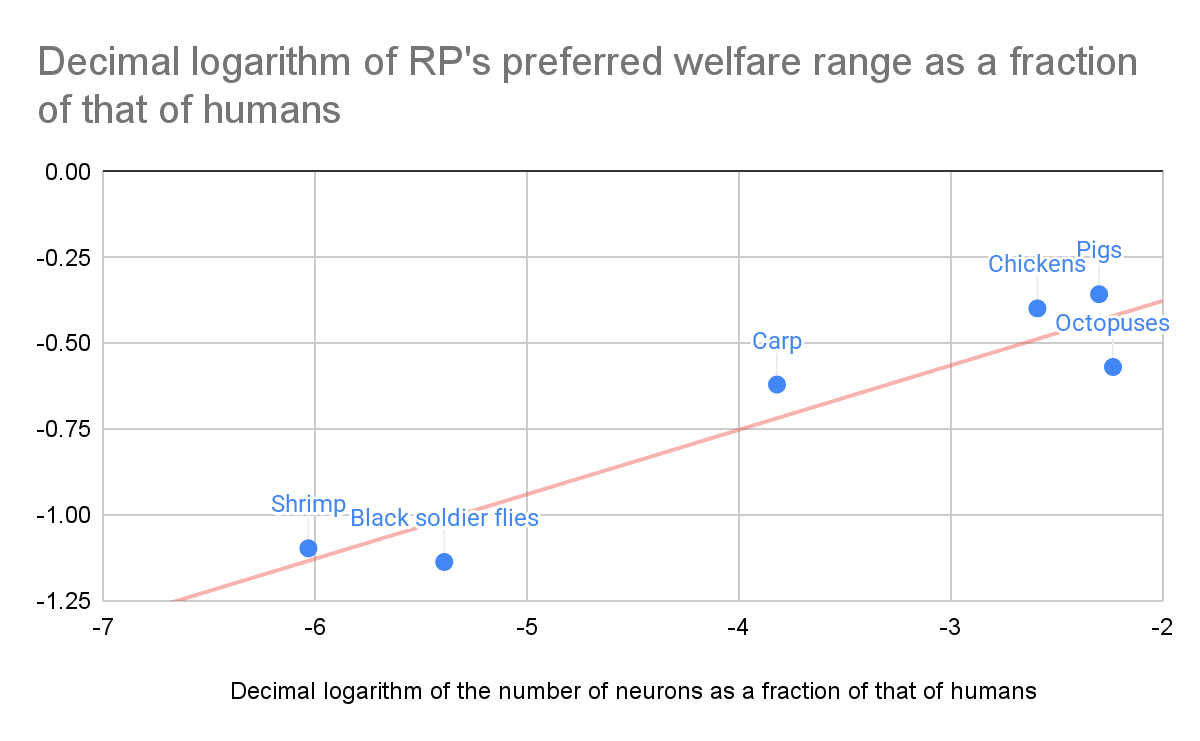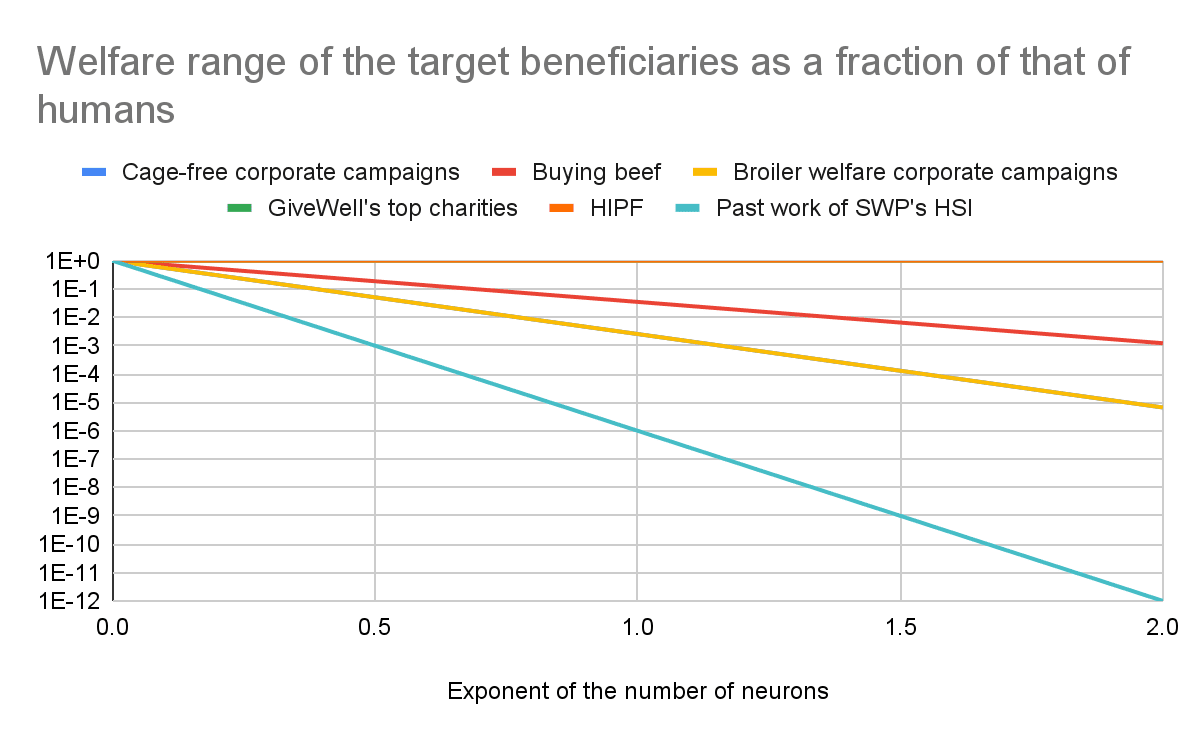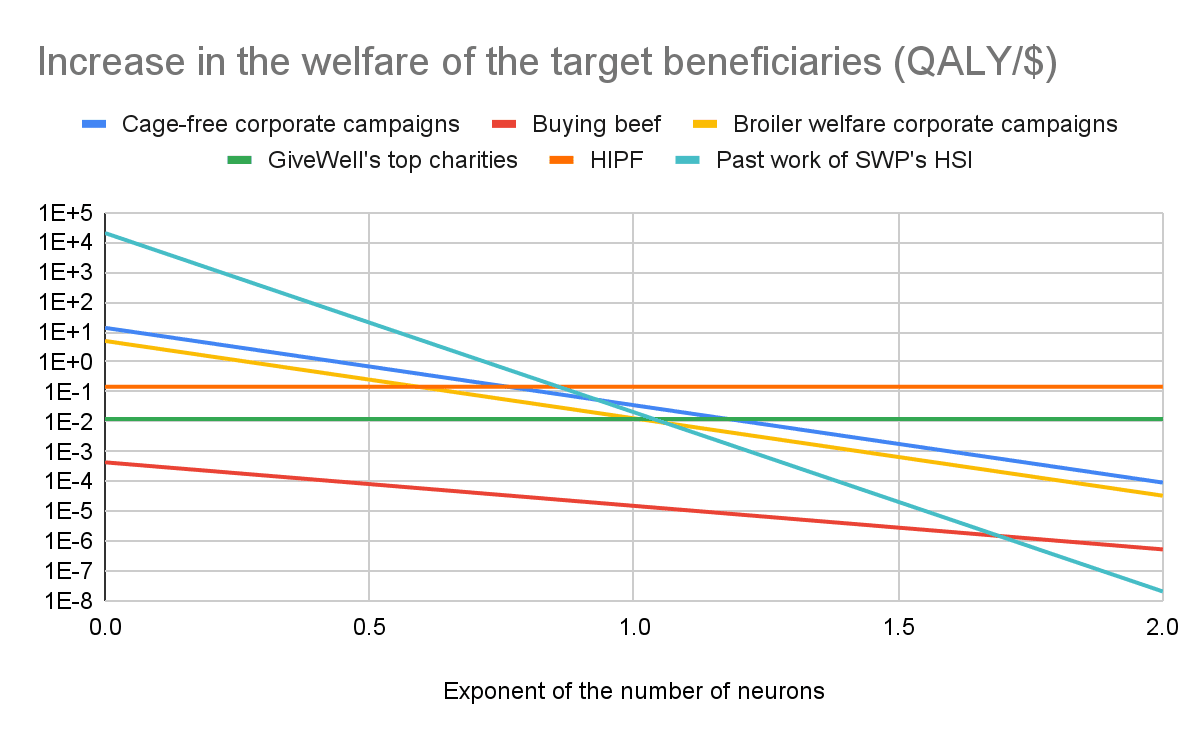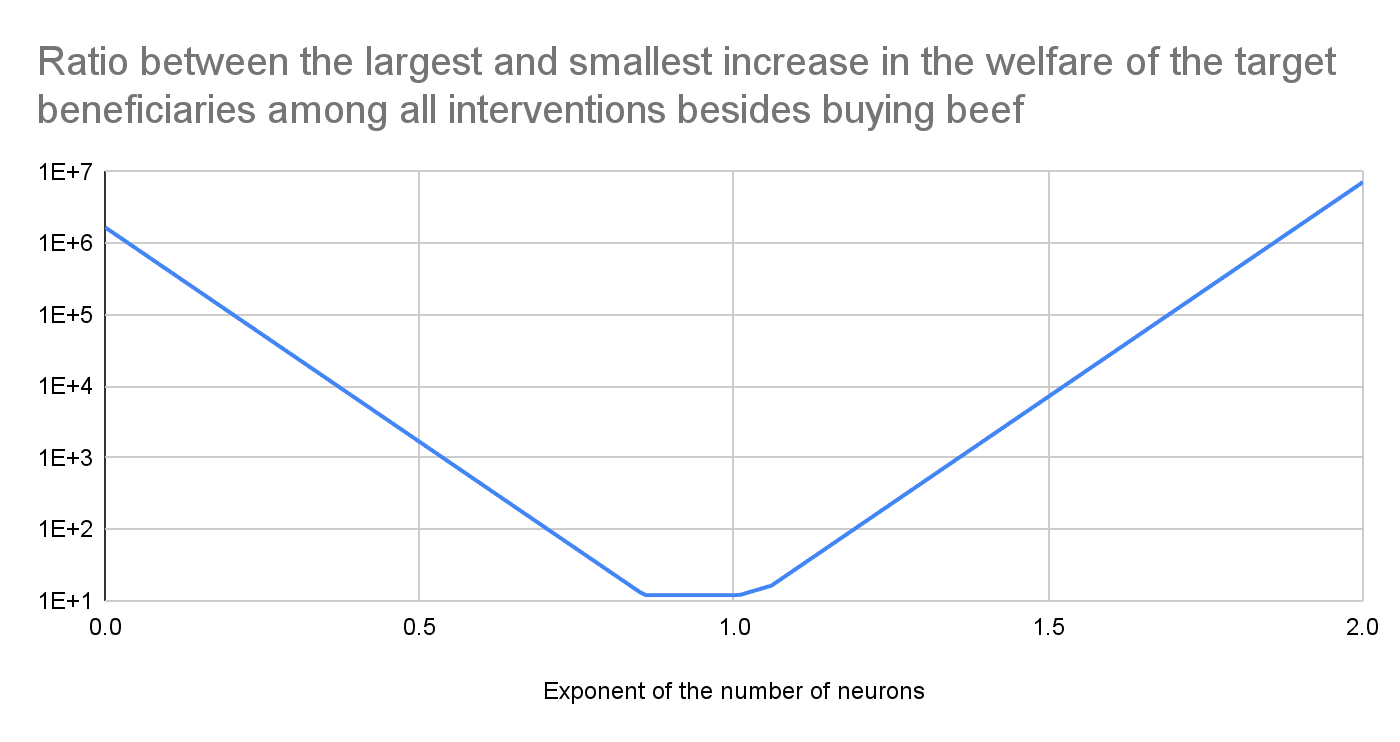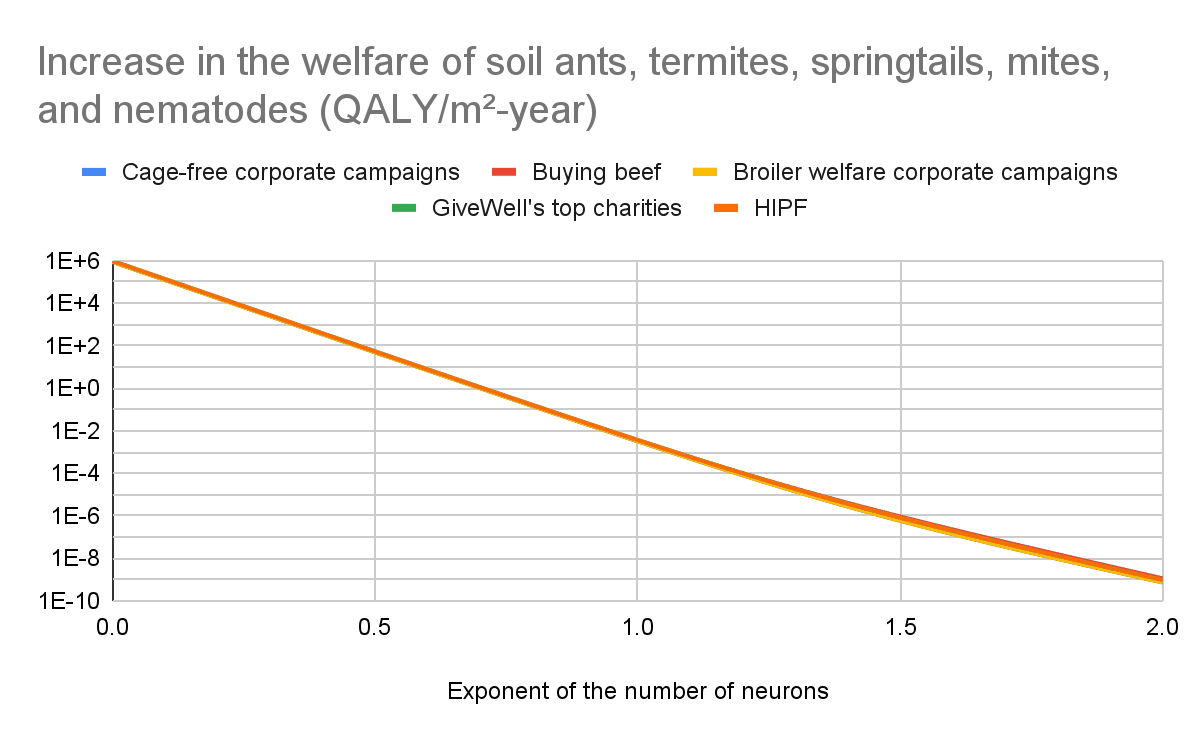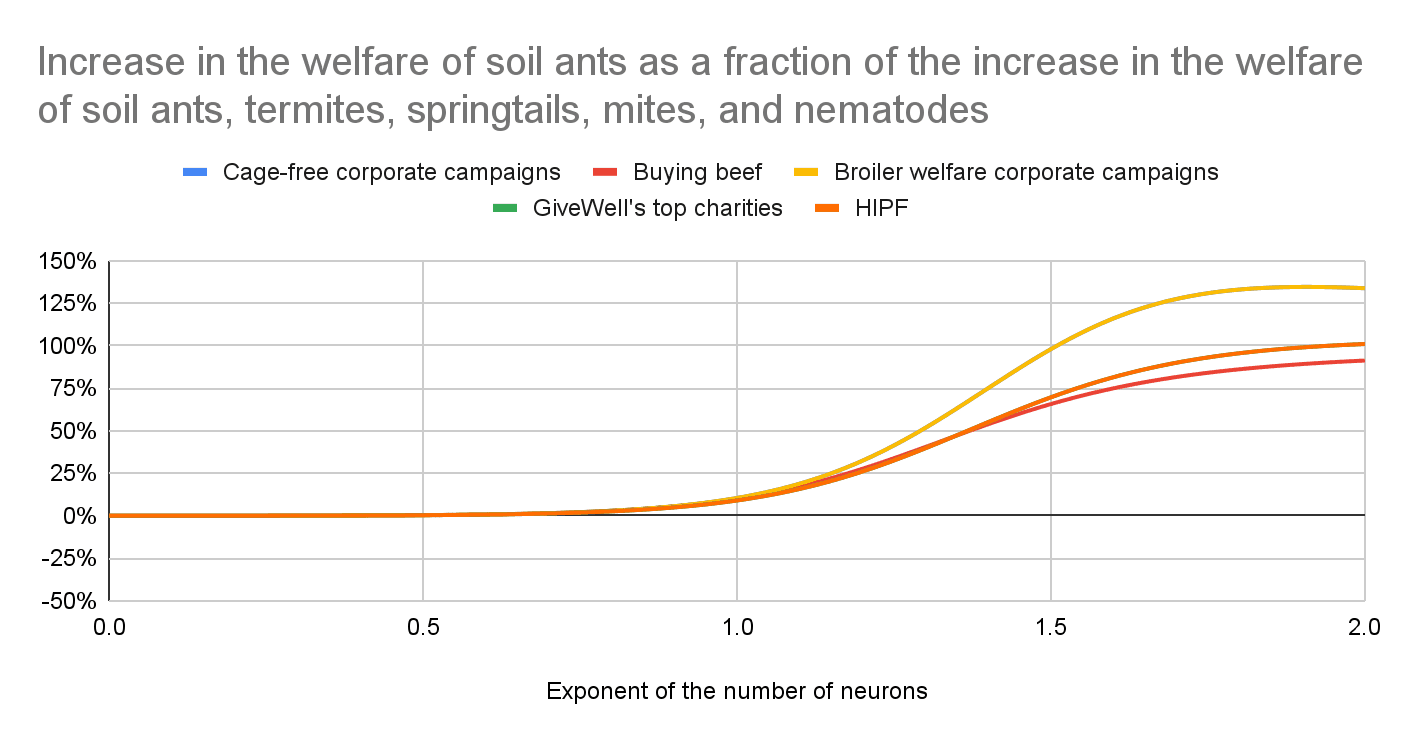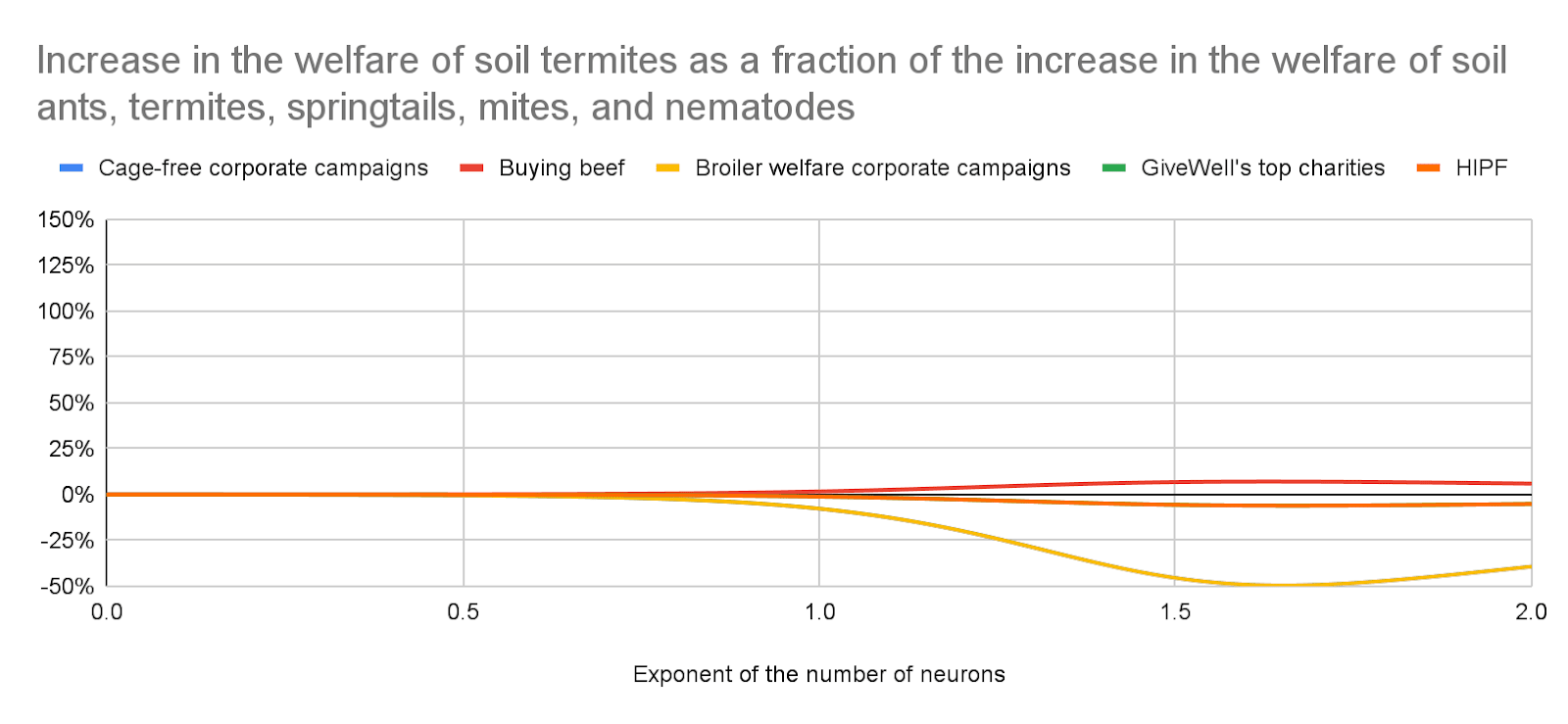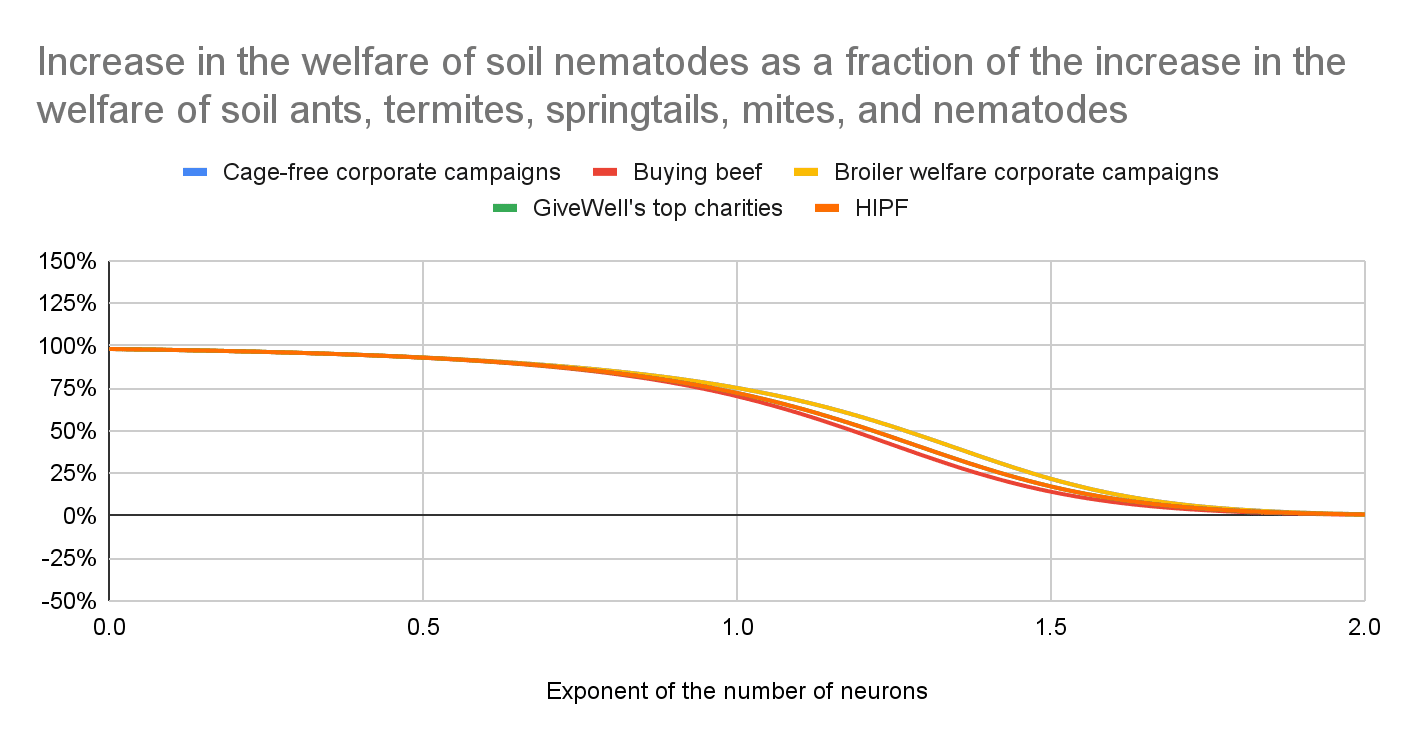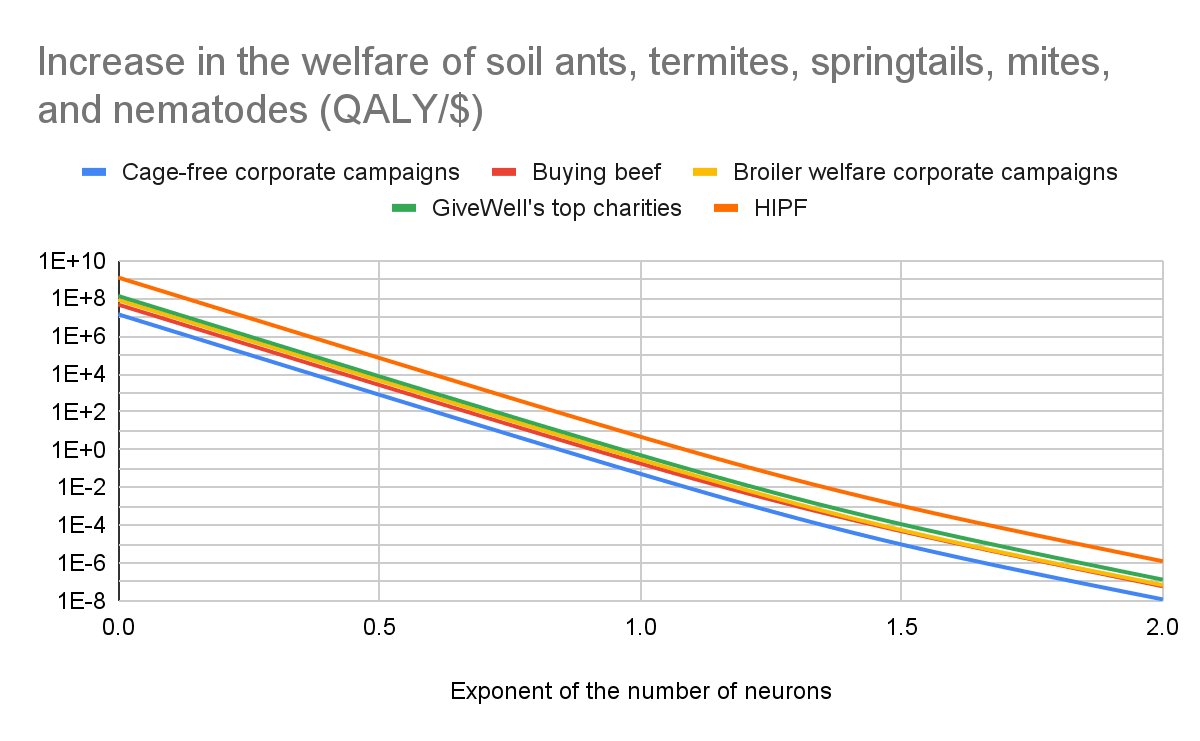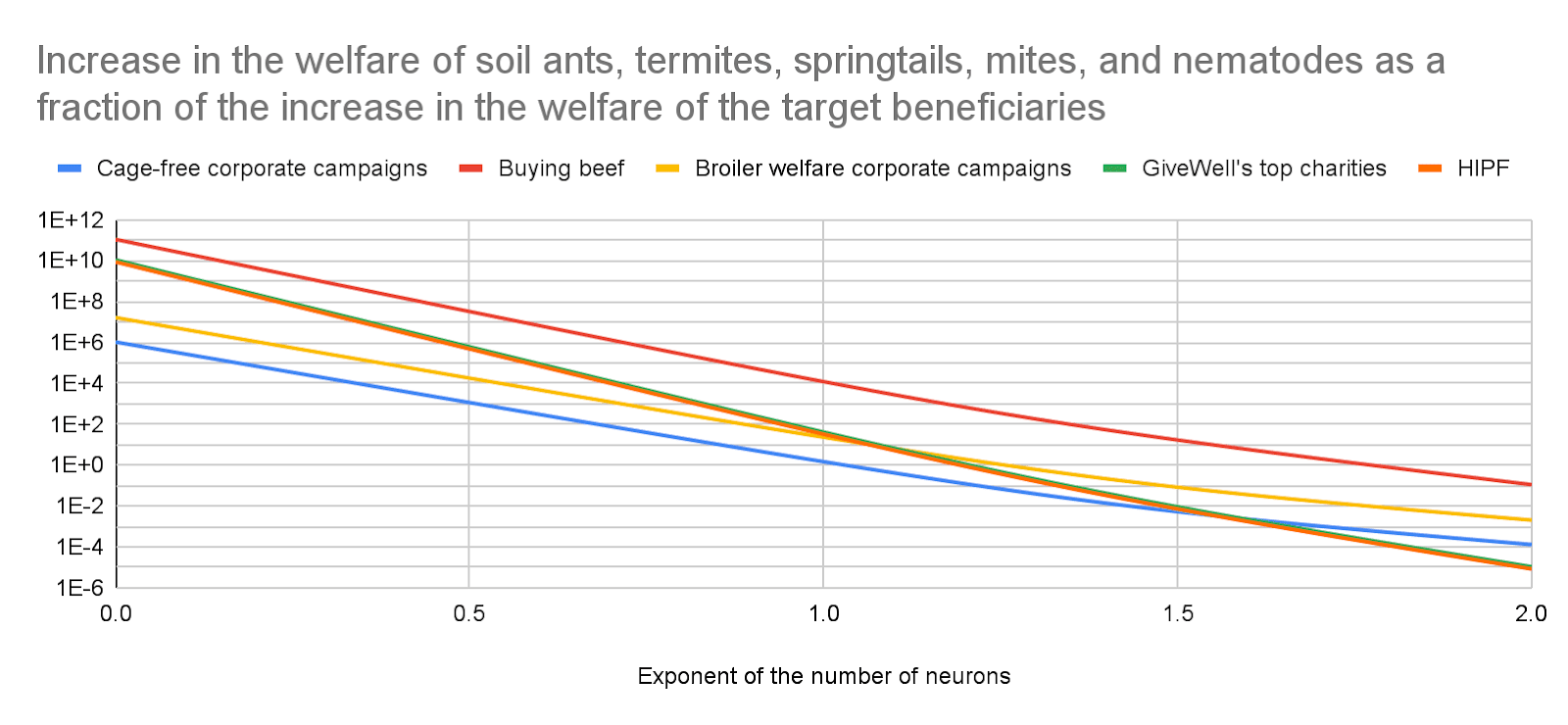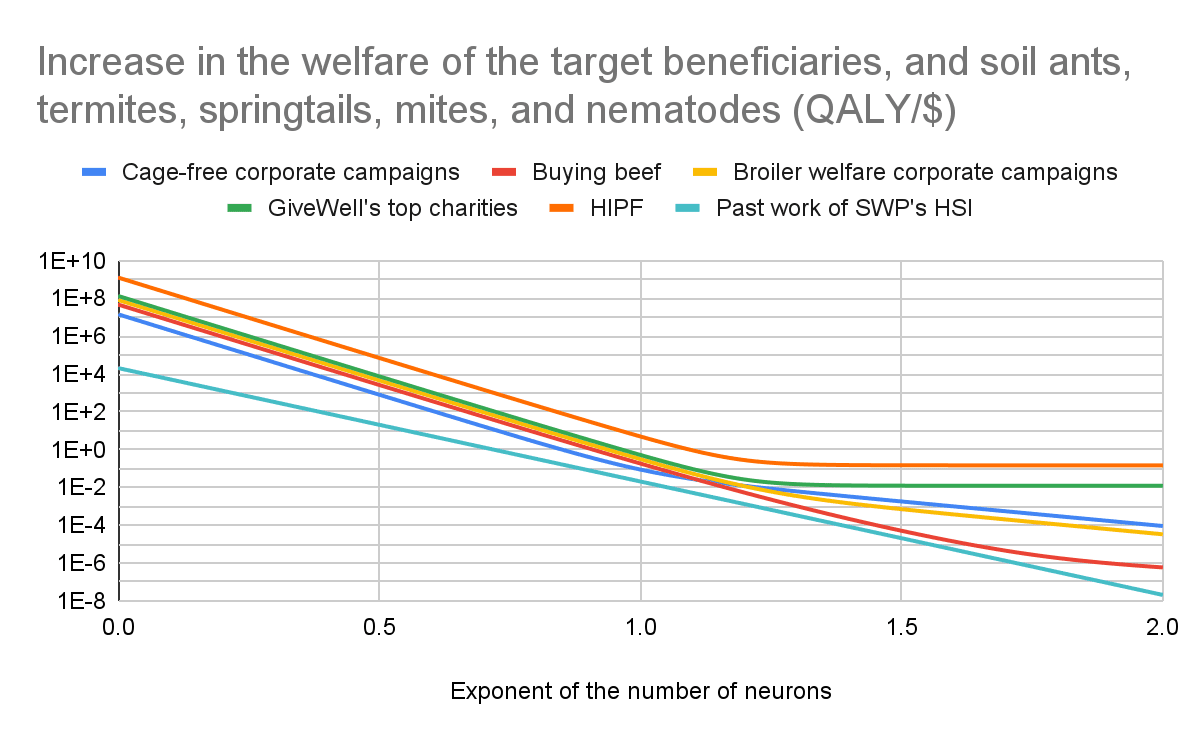Saving human lives cheaply is the most cost-effective way of increasing animal welfare?
By Vasco Grilo🔸 @ 2025-08-07T16:29 (+23)
Summary
- I estimate the cost-effectiveness of cage-free corporate campaigns, buying beef, broiler welfare corporate campaigns, GiveWell’s top charities, Centre for Exploratory Altruism Research’s (CEARCH’s) High Impact Philanthropy Fund (HIPF), and Shrimp Welfare Project’s (SWP’s) Humane Slaughter Initiative (HSI) accounting for target beneficiaries, and soil ants, termites, springtails, mites, and nematodes. The welfare of these soil animals is affected due to changes in land use which impact their abundance.
- I suppose welfare per animal-year is proportional to the welfare range, the difference between the maximum and minimum welfare per unit time, and that this is a power law of the number of neurons. In particular, I use welfare ranges as a fraction of that of humans equal to “number of neurons as a fraction of that of humans”^“exponent of the number of neurons”, with the exponent ranging from 0 to 2. For an exponent of:
- 0, all animals have the welfare range of humans.
- 0.188:
- The welfare ranges are pretty similar to the estimates in Bob Fischer’s book about comparing animal welfare across species, which contains what Rethink Priorities (RP) stands behind now. An exponent of 0.188 explains 78.6 % of their variance.
- The number of neurons has to become 209 k (= 10^(1/0.188)) times as large for the welfare range to become 10 times as large.
- 0.5, corresponding to my best guesses for the welfare ranges, the number of neurons has to become 100 (= 10^(1/0.5)) times as large for the welfare range to become 10 times as large.
- 1, the welfare ranges are proportional to the number of neurons.
- 2, the number of neurons has to become 3.16 (= 10^(1/2)) times as large for the welfare range to become 10 times as large.
- I calculate the following decrease in the living time of soil animals (for context, I estimated cage-free corporate campaigns improve 10.8 chicken-years per $):
- For cage-free corporate campaigns, 57.7 M soil-animal-year/$.
- For buying beef, 189 M soil-animal-year/$.
- For broiler welfare corporate campaigns, 331 M soil-animal-year/$.
- For GiveWell’s top charities, 539 M soil-animal-year/$.
- For HIPF, 5.07 billion soil-animal-year/$.
- I believe effects on soil animals are much larger than those on target beneficiaries. I am confident the exponent of the number of neurons is the parameter which affects the ratio between the effects on soil animals and target beneficiaries the most by far, and effects on soil animals dominate at least for values of the exponent up to 1, which are the ones I consider plausible. I get the following increase in the welfare of soil ants, termites, springtails, mites, and nematodes as a fraction of the increase in the welfare of the target beneficiaries. For exponents of the number of neurons of 0.19, 0.5, and 1:
- For cage-free corporate campaigns, 77.8 k, 1.15 k, and 1.48.
- For buying beef, 4.92 billion, 32.4 M, and 12.1 k.
- For broiler welfare corporate campaigns, 1.22 M, 18.0 k, and 23.3.
- For GiveWell’s top charities, 263 M, 610 k, and 41.5.
- For HIPF, 206 M, 477 k, and 32.5.
- I estimate effects on soil animals would still be much larger than those on the target beneficiaries for a welfare per animal-year of exactly 0 for animals with fewer neurons than those considered in Bob’s book, and an exponent of the number of neurons of 0.19 which explains very well its estimates. I calculate soil ants and termites have 2.91 and 1.16 times as many neurons as shrimp, so effects on them would still be relevant. I get the following increase in the welfare of soil ants and termites as a fraction of the increase in the welfare of the target beneficiaries for an exponent of 0.19 (the chicken welfare corporate campaigns would decrease animal welfare):
- For cage-free corporate campaigns, -20.4.
- For buying beef, 3.31 M.
- For broiler welfare corporate campaigns, -321.
- For GiveWell’s top charities, 83.6 k.
- For HIPF, 65.5 k.
- Among the interventions I analysed besides SWP’s HSI, the logarithm of the increase in agricultural-land-years per $ explains over 90 % of the variance in the logarithm of the increase in the welfare of the target beneficiaries, and soil ants, termites, springtails, mites, and nematodes per $ for an exponent of the number of neurons up to 1.12. In other words, one can predict this increase in welfare per $ from the increase in agricultural-land-years per $ alone for those exponents. This is because the effects on soil animals are much larger than those on the target beneficiaries in this case, and the increase in the welfare of soil animals per unit area is similar for those interventions.
- I continue to recommend funding HIPF, which is the most cost-effective intervention among the ones I analysed for any exponent of the number of neurons. In addition, for my preferred exponent of 0.5, I estimate:
- Cage-free corporate campaigns are 1.14 % as cost-effective (as funding HIPF).
- Buying beef is 3.72 % as cost-effective.
- Broiler welfare corporate campaigns are 6.51 % as cost-effective.
- GiveWell’s top charities are 10.6 % as cost-effective.
- SWP’s HSI has been 0.0292 % as cost-effective.
- I do not recommend funding interventions targeting farmed invertebrates. I think SWP’s HSI is among the most cost-effective of these accounting only for target beneficiaries, and it has been the least cost-effective intervention among the ones I analysed by far for any exponent of the number of neurons accounting for target beneficiaries, and soil ants, termites, springtails, mites, and nematodes.
- I recommend investigating whether soil ants and nematodes have positive or negative lives, starting with soil nematodes. I estimate effects on soil ants account for most of the effects on soil ants, termites, springtails, mites, and nematodes for all the interventions I analysed for an exponent of the number of neurons of 1.38 or higher, and that effects on soil nematodes account for most of those effects for all the interventions I analysed for an exponent of 1.18 or lower. I supposed soil nematodes have negative lives, but can easily see them having positive lives, and would conclude all the interventions I analysed besides SWP’s HSI are harmful in this case.
Methods
I estimated the cost-effectiveness of a few interventions accounting for target beneficiaries, and soil springtails, mites, and nematodes based on the welfare ranges as a fraction of that of humans RP initially presented. Meanwhile, Bob, who led RP’s moral weight project, said on July 28 that “What we [RP] stand behind now is really just what we published in the book [the one I mentioned in the summary; here is a comparison between the book’s and RP’s initial estimates for the welfare ranges]”. The tentative estimates presented in Chapter 8 were obtained aggregating the welfare ranges conditional on sentience as a fraction of that of humans of 3 models, the equality, neurophysiological, and simple additive models, which are weighted at 10 %, 30 %, and 60 %. An organism without any neurons has a welfare range conditional on sentience as a fraction of that of humans under the neurophysiological of 0, but this only directly limits the welfare range conditional on sentience as a fraction of that of humans to 0.7 (= 1 - 0.3). I guess the absence of neurons directly limits the welfare range conditional on sentience as a fraction of that of humans much more. I guess it is better to assume the contribution of non-structural properties to the welfare range as a fraction of that of humans is moderated by structural properties.
In this post, I estimate the cost-effectiveness of cage-free corporate campaigns, buying beef, broiler welfare corporate campaigns, GiveWell’s top charities, CEARCH’s HIPF, and SWP’s HSI accounting for target beneficiaries, and soil ants, termites, springtails, mites, and nematodes. The welfare of these soil animals is affected due to changes in land use which impact their abundance.
I suppose welfare per animal-year is proportional to the welfare range, the difference between the maximum and minimum welfare per unit time, and that this is a power law of the number of neurons. In particular, I use welfare ranges as a fraction of that of humans equal to “number of neurons as a fraction of that of humans”^“exponent of the number of neurons”, with the exponent ranging from 0 to 2. For an exponent of:
- 0, all animals have the welfare range of humans.
- 0.188:
- The welfare ranges are pretty similar to the estimates in Bob’s book about comparing animal welfare across species, which contains what RP stands behind now. An exponent of 0.188 explains 78.6 % of their variance.
- The number of neurons has to become 209 k (= 10^(1/0.188)) times as large for the welfare range to become 10 times as large.
- 0.5, corresponding to my best guesses for the welfare ranges, the number of neurons has to become 100 (= 10^(1/0.5)) times as large for the welfare range to become 10 times as large.
- 1, the welfare ranges are proportional to the number of neurons.
- 2, the number of neurons has to become 3.16 (= 10^(1/2)) times as large for the welfare range to become 10 times as large.
RP’s moral weight project included a report by Adam Shriver concluding “there is no straightforward empirical evidence or compelling conceptual arguments indicating that relative differences in neuron counts within or between species reliably predicts welfare relevant functional capacities”. I guess there are other factors besides the number of neurons that influence the welfare range. However, an exponent of 0.188 explains 78.6 % of the variance of the estimates in Bob’s book. So I prefer to rely on a simple formula to decrease noise, and easily obtain estimates for animals not covered in the book to explore implications for cause prioritisation. I get that exponent from the slope of a linear regression with null intercept of the logarithm of RP’s preferred welfare range as a fraction of that of humans on the logarithm of the number of neurons as a fraction of that of humans.
My formula for the welfare range as a fraction of that of humans implies a welfare range as a fraction of that of humans of 0 for organisms without neurons, which I think is an underestimate, as I am not certain they have a constant welfare per unit time as a result of not having neurons. Furthermore, I speculate effects on microorganisms, which do not have neurons, are much larger than those on soil animals, although positively correlated.
I calculate the increase in the welfare of the target beneficiaries per $ by multiplying my past estimates by my updated welfare range of the target beneficiaries as a fraction of that I used to obtain them.
I suppose the welfare per animal-year of soil ants/termites/springtails/mites/nematodes is -25 % that of fully happy soil ants/termites/springtails/mites/nematodes. I assume this holds for all biomes, but I guess there is variation in reality. Karolina Sarek, Joey Savoie, and David Moss estimated -42 % for the “wild bug” in 2018, which is more negative than what I assumed. My best guess is that soil animals have negative lives, but I am very uncertain.
I get the number of soil ants, termites, springtails, and mites per unit area for 10 biomes using the means in Table S4 of Rosenberg et al. (2023). I determine the number of soil nematodes per unit area by multiplying the number of soil arthropods from this table by 48.9, which is my estimate for the ratio between the number of soil nematodes and soil arthropods globally.
I use my past estimates for the increase in agricultural land per $. Nevertheless, instead of assuming additional agricultural land is cropland replacing a single biome, as I did before, I consider a mix of cropland and pastures replacing a mix of biomes in proportions guessed by Gemini 2.5 on 2 August 2025. I assume HSI’s effects on soil ants, termites, springtails, mites, and nematodes are negligible compared with those on shrimp because it does not change the amount of feed-kg per food-kg, unlike cage-free and broiler welfare corporate campaigns.
Here are my calculations.
Results
Number of soil animals affected
For context, I estimated cage-free corporate campaigns improve 10.8 chicken-years per $. “E+” stands for “*10^”.
| Interventions | Initial number of soil animals per m² of the affected land | Final number of soil animals per m² of the affected land | Decrease in the number of soil animals per m² | Decrease in the living time of soil animals (animal-year/$) |
| Cage-free corporate campaigns | 4.88E+06 | 1.36E+06 | 3.52E+06 | 5.77E+07 |
| Buying beef | 4.58E+06 | 9.21E+05 | 3.66E+06 | 1.89E+08 |
| Broiler welfare corporate campaigns | 4.88E+06 | 1.36E+06 | 3.52E+06 | 3.31E+08 |
| GiveWell's top charities | 4.88E+06 | 9.50E+05 | 3.93E+06 | 5.39E+08 |
| HIPF | 4.88E+06 | 9.50E+05 | 3.93E+06 | 5.07E+09 |
Linear regression with null intercept of the logarithm of RP’s preferred welfare range as a fraction of that of humans on the logarithm of the number of neurons as a fraction of that of humans
An exponent of the number of neurons of 0.188, corresponding to the slope of the line below, explains 78.6 % of the variance in RP’s preferred estimates for the welfare range.
Welfare range of the target beneficiaries as a fraction of that of humans
The welfare range of the target beneficiaries decays faster (with the exponent of the number of neurons) for ones with fewer neurons. The slope of the straight lines below is the logarithm of the number of neurons as a fraction of that of humans.
Increase in the welfare of the target beneficiaries
I believe one should consider effects on soil ants, termites, springtails, mites, and nematodes. However, accounting only for the target beneficiaries, prioritisation among the interventions I have analysed besides buying beef matters the least for an exponent of the number of neurons ranging from 0.86 to 1, where the ratio between the highest and lowest cost-effectiveness among those interventions is 12.0.
For an exponent of 1, in which case the welfare range is proportional to the number of neurons, chicken welfare corporate campaigns increase the welfare of chickens roughly as cost-effectively as SWP’s HSI has increased the welfare of shrimp
Increase in the welfare of soil ants, termites, springtails, mites, and nematodes
The increase in the welfare of soil soil ants, termites, springtails, mites, and nematodes per unit area is similar for all interventions because Gemini 2.5 guessed the additional agricultural land would replace biomes in approximately the same way. In reality, there is variation even within a single type of intervention.
Increase in the welfare of soil ants as a fraction of the increase in the welfare of soil ants, termites, springtails, mites, and nematodes
The effect on soil ants is the major driver of the effects on soil ants, termites, springtails, mites, and nematodes for a high exponent of the number of neurons because they have the most neurons per individual among those animals.
Increase in the welfare of soil termites as a fraction of the increase in the welfare of soil ants, termites, springtails, mites, and nematodes
Buying beef is the only intervention I analysed increasing the welfare of soil termites. However, crops and pastures have the least soil ants/springtails/mites/nematodes per unit area besides deserts, and xeric shrublands, which would very hardly be replaced by the additional agricultural land, and effects on soil termites account for a tiny fraction of the effects on soil ants, termites, springtails, mites, and nematodes for an exponent of the number of neurons lower than 1, which I endorse. So I conclude the welfare of those animals considered together would still decrease for land use changes different from the ones guessed by Gemini.
Increase in the welfare of soil nematodes as a fraction of the increase in the welfare of soil ants, termites, springtails, mites, and nematodes
The effect on soil nematodes is the major driver of the effects on soil ants, termites, springtails, mites, and nematodes for a low exponent of the number of neurons because they have the least neurons per individual among those animals.
Increase in the welfare of soil ants, termites, springtails, mites, and nematodes
There is some variation in the increase in the welfare of soil ants, termites, springtails, mites, and nematodes per $ across interventions. Yet, there is way more variation with the exponent of the number of neurons within a single intervention.
Increase in the welfare of soil ants, termites, springtails, mites, and nematodes as a fraction of the increase in the welfare of the target beneficiaries
I believe effects on soil animals are much larger than those on target beneficiaries. I am confident the exponent of the number of neurons is the parameter which affects the ratio between the effects on soil animals and target beneficiaries the most by far, and effects on soil animals dominate at least for values of the exponent up to 1, which are the ones I consider plausible. I get the following increase in the welfare of soil ants, termites, springtails, mites, and nematodes as a fraction of the increase in the welfare of the target beneficiaries. For exponents of the number of neurons of 0.19, 0.5, and 1:
- For cage-free corporate campaigns, 77.8 k, 1.15 k, and 1.48.
- For buying beef, 4.92 billion, 32.4 M, and 12.1 k.
- For broiler welfare corporate campaigns, 1.22 M, 18.0 k, and 23.3.
- For GiveWell’s top charities, 263 M, 610 k, and 41.5.
- For HIPF, 206 M, 477 k, and 32.5.
Increase in the welfare of soil ants and termites as a fraction of the increase in the welfare of the target beneficiaries
I estimate effects on soil animals would still be much larger than those on the target beneficiaries for a welfare per animal-year of exactly 0 for animals with fewer neurons than those considered in Bob’s book, and an exponent of the number of neurons of 0.19 which explains very well its estimates (an exponent of 0.188 explains 78.6 % of their variance). I calculate soil ants and termites have 2.91 (= 250*10^3/(86*10^3)) and 1.16 (= 100*10^3/(86*10^3)) times as many neurons as shrimp, so effects on them would still be relevant. I get the following increase in the welfare of soil ants and termites as a fraction of the increase in the welfare of the target beneficiaries for an exponent of 0.19 (the chicken welfare corporate campaigns would decrease animal welfare):
- For cage-free corporate campaigns, -20.4.
- For buying beef, 3.31 M.
- For broiler welfare corporate campaigns, -321.
- For GiveWell’s top charities, 83.6 k.
- For HIPF, 65.5 k.
Buying beef, GiveWell’s top charities, and HIPF increase the welfare of soil ants and termites for any exponent. The chicken welfare corporate campaigns decrease it before the sharp points below, and increase it afterwards.
Increase in the welfare of the target beneficiaries, and soil ants, termites, springtails, mites, and nematodes
HIPF is much more cost-effective than the other interventions for any exponent of the number of neurons. The slope of the cost-effectiveness of all interventions besides the past work of SWP’s HSI becomes less negative once the effects on the target beneficiaries start to dominate, since these have more neurons than soil ants, termites, springtails, mites, and nematodes.
Coefficient of determination of the linear regression of the logarithm of the increase in the welfare of the target beneficiaries, and soil ants, termites, springtails, mites, and nematodes per $ on the logarithm of the increase in agricultural-land-years per $
Among the interventions I analysed besides SWP’s HSI, the logarithm of the increase in agricultural-land-years per $ explains over 90 % of the variance in the logarithm of the increase in the welfare of the target beneficiaries, and soil ants, termites, springtails, mites, and nematodes per $ for an exponent of the number of neurons up to 1.12. In other words, one can predict this increase in welfare per $ from the increase in agricultural-land-years per $ alone for those exponents. This is because the effects on soil animals are much larger than those on the target beneficiaries in this case, and the increase in the welfare of soil animals per unit area is similar for those interventions.
Results for my preferred welfare ranges
Below are the results for my preferred welfare ranges respecting an exponent of the number of neurons of 0.5. My exponent is significantly higher than the value of 0.188 which I estimate explains 78.6 % of the variance in RP’s preferred estimates. So my exponent implies the welfare range increases much closer to linearly with the number of neurons, although still significantly sublinearly.
There is variation in the cost-effectiveness of each of the above interventions, and therefore picking the most cost-effective opportunities within each type matters. For example, funding the most cost-effective instead of random cage-free corporate campaigns may be more important than funding random broiler welfare corporate campaigns instead of random cage-free corporate campaigns.
| Intervention | Cage-free corporate campaigns | Buying beef | Broiler welfare corporate campaigns | GiveWell's top charities | HIPF | Past work of SWP's HSI |
| Decrease in the living time of soil animals (animal-year/$) | 5.77E+07 | 1.89E+08 | 3.31E+08 | 5.39E+08 | 5.07E+09 | |
| Exponent of the number of neurons regarding my preferred welfare range | 0.500 | 0.500 | 0.500 | 0.500 | 0.500 | 0.500 |
| Welfare range of the target beneficiaries as a fraction of that of humans | 0.0507 | 0.187 | 0.0507 | 1.00 | 1.00 | 0.00100 |
| Welfare range of the target beneficiaries as a fraction of that I have used in the past | 15.3% | 36.3% | 15.3% | 100% | 100% | 3.23% |
| Increase in the welfare of the target beneficiaries (QALY/$) | 0.701 | 8.12E-05 | 0.255 | 0.0123 | 0.148 | 20.6 |
| Increase in the welfare of soil ants (QALY/m²-year) | 0.197 | 0.211 | 0.197 | 0.197 | 0.197 | |
| Increase in the welfare of soil termites (QALY/m²-year) | -0.228 | 0.0543 | -0.228 | -0.0397 | -0.0397 | |
| Increase in the welfare of soil springtails (QALY/m²-year) | 1.07 | 0.474 | 1.07 | 0.932 | 0.932 | |
| Increase in the welfare of soil mites (QALY/m²-year) | 2.37 | 2.88 | 2.37 | 2.77 | 2.77 | |
| Increase in the welfare of soil nematodes (QALY/m²-year) | 45.6 | 47.4 | 45.6 | 50.9 | 50.9 | |
| Increase in the welfare of soil ants, termites, springtails, mites, and nematodes (QALY/m²-year) | 49.0 | 51.0 | 49.0 | 54.8 | 54.8 | |
| Increase in the welfare of soil ants as a fraction of the increase in the welfare of soil ants, termites, springtails, mites, and nematodes | 0.402% | 0.414% | 0.402% | 0.360% | 0.360% | |
| Increase in the welfare of soil termites as a fraction of the increase in the welfare of soil ants, termites, springtails, mites, and nematodes | -0.466% | 0.106% | -0.466% | -0.0725% | -0.0725% | |
| Increase in the welfare of soil springtails as a fraction of the increase in the welfare of soil ants, termites, springtails, mites, and nematodes | 2.19% | 0.930% | 2.19% | 1.70% | 1.70% | |
| Increase in the welfare of soil mites as a fraction of the increase in the welfare of soil ants, termites, springtails, mites, and nematodes | 4.83% | 5.65% | 4.83% | 5.06% | 5.06% | |
| Increase in the welfare of soil nematodes as a fraction of the increase in the welfare of soil ants, termites, springtails, mites, and nematodes | 93.0% | 92.9% | 93.0% | 92.9% | 92.9% | |
| Increase in the welfare of soil ants, termites, springtails, mites, and nematodes (QALY/$) | 803 | 2.63E+03 | 4.60E+03 | 7.50E+03 | 7.06E+04 | |
| Increase in the welfare of soil ants, termites, springtails, mites, and nematodes as a fraction of the increase in the welfare of the target beneficiaries | 1.15E+03 | 3.24E+07 | 1.80E+04 | 6.10E+05 | 4.77E+05 | |
| Increase in the welfare of the target beneficiaries, and soil ants, termites, springtails, mites, and nematodes (QALY/$) | 804 | 2.63E+03 | 4.60E+03 | 7.50E+03 | 7.06E+04 | 20.6 |
| Increase in the welfare of the target beneficiaries, and soil ants, termites, springtails, mites, and nematodes as a fraction of that caused by funding HIPF | 1.14% | 3.72% | 6.51% | 10.6% | 100% | 0.0292% |
My recommendations
I continue to recommend funding HIPF, which is the most cost-effective intervention among the ones I analysed for any exponent of the number of neurons. In addition, for my preferred exponent of 0.5, I estimate:
- Cage-free corporate campaigns are 1.14 % as cost-effective (as funding HIPF).
- Buying beef is 3.72 % as cost-effective.
- Broiler welfare corporate campaigns are 6.51 % as cost-effective.
- GiveWell’s top charities are 10.6 % as cost-effective.
- SWP’s HSI has been 0.0292 % as cost-effective.
I do not recommend funding interventions targeting farmed invertebrates. I think SWP’s HSI is among the most cost-effective of these accounting only for target beneficiaries, and it has been the least cost-effective intervention among the ones I analysed by far for any exponent of the number of neurons accounting for target beneficiaries, and soil ants, termites, springtails, mites, and nematodes.
I recommend investigating whether soil ants and nematodes have positive or negative lives, starting with soil nematodes. I estimate effects on soil ants account for most of the effects on soil ants, termites, springtails, mites, and nematodes for all the interventions I analysed for an exponent of the number of neurons of 1.38 or higher, and that effects on soil nematodes account for most of those effects for all the interventions I analysed for an exponent of 1.18 or lower. I supposed soil nematodes have negative lives, but can easily see them having positive lives, and would conclude all the interventions I analysed besides SWP’s HSI are harmful in this case.
My recommendations are supposed to hold under my AI timelines. I like Ege Erdil’s median time of 20 years until full automation of remote work, and I would not neglect impact after this. CEARCH granted 63 k$ to decrease the consumption of sugar-sweetened beverages (SSBs) to decrease the burden of diabetes mellitus type 2 (DMT2), and 150 k$ to decrease the consumption of sodium (in salt) to decrease the burden of high systolic blood pressure (HSBP) until 27 May 2025, and the burden per capita of DMT2 has been increasing, and that of HSBP has been stable despite an increasing real gross domestic product (real GDP) per capita. However, I would recommend buying beef, or funding broiler welfare corporate campaigns or HIPF only accounting for effects over the next 10 years. In this case:
- I guess funding HIPF would become 3.88 % as cost-effective. I estimate advocacy for taxing SSBs would become 3.88 % as cost-effective.
- I expect buying beef would remain as cost-effective as before, 95.9 % (= 0.0372*1/0.0388) as cost-effective as funding HIPF. I guess the vast majority of its impact materialises in less than 10 years.
- I calculate broiler welfare corporate campaigns would become 75 % (= (10 - 2.5)/10) as cost-effective, 1.26 (= 0.0651*0.75/0.0388) times as cost-effective as funding HIPF. I guess they accelerate welfare reforms by 10 years, and have an impact linearly increasing from affecting no to all broilers over 5 years, which is equivalent to starting affecting all broilers in 2.5 years (= 5/2).
Acknowledgements
Thanks to Michael St. Jules for feedback on the draft. The views expressed in the post are my own.
tlevin @ 2025-08-24T16:35 (+14)
I appreciate these analyses, but given the very high sensitivity of the bottom lines to parameters like how welfare ranges correspond to neuron counts or other facts about the animals in question, I find it implausible that the best donation option is to fund the intervention with the highest mean estimate rather than either 1) fund more research into those parameters or 2) save/invest until such research has happened. Maybe future posts could examine the tradeoff between funding/waiting for such research versus funding the direct interventions now?
Vasco Grilo🔸 @ 2025-08-24T17:12 (+12)
Thanks for the comment. I actually agree that funding research explicitly aiming to decrease the uncertainty about the effects on soil animals would be more cost-effective than funding the cheapest ways to save human lives. However, I do not know about any concrete donation opportunities to support that research. I asked people from RP, the Welfare Footprint Institute (WFI), and Wild Animal Initiative (WAI) about it 3 months ago, and said I would be happy to donate 3 k$ myself. Only Cynthia Schuck-Paim from WFI replied saying Wladimir Alonso from WFI is working on a review related to this post. @tlevin, let me know if you know about such opportunities, or people who may know about them.
Vasco Grilo🔸 @ 2025-11-03T20:33 (+11)
I get the number of soil ants, termites, springtails, and mites per unit area for 10 biomes using the means in Table S4 of Rosenberg et al. (2023). I determine the number of soil nematodes per unit area by multiplying the number of soil arthropods from this table by 48.9, which is my estimate for the ratio between the number of soil nematodes and soil arthropods globally.
This resulted in cropland and pasture being the biomes with the least soil animals per unit area besides deserts, and xeric shrublands, which would very hardly be replaced by agricultural land. So I was thinking that increasing this would decrease soil-animal-years. However, from Figure 1a of Li et al. (2022), which is below, it is unclear whether cropland and pasture have more or fewer soil nematodes than "primary habitat (undisturbed natural habitat)", or "secondary habitat (recovering, previously disturbed natural habitat)". For example, secondary habitat which is "unmanaged (no documented or observed direct human disturbance)" is estimated to have fewer soil nematodes than cropland and pasture which are unmanaged or "managed (more or less disturbed by various human activities like fertilization, tillage, grazing, logging, etc.)". As a result, I am very uncertain not only about whether soil nematodes have positive or negative lives, but also about whether increasing agricultural land increases or decreases soil-animal-years.

Figure 7 of the meta-analysis of Pothula et al. (2019) also suggests it is very unclear whether agricultural land has more or fewer soil nematodes than forests.
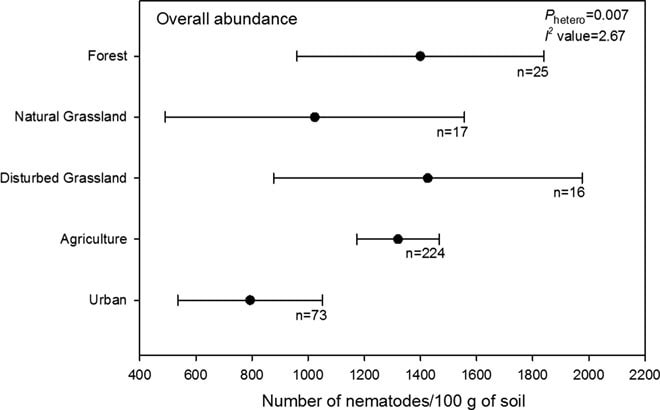
White (2022) concludes "nematode abundance is higher in managed than unmanaged primary and secondary habitats".
I had already recommended decreasing the uncertainty about whether soil animals have positive or negative lives over funding HIPF. However, I now feel like it does not even make sense to recommend global health interventions, or others which do not decrease the uncertainty about effects on soil animals or microorganisms.
Wladimir J. Alonso @ 2025-08-25T00:39 (+9)
Vasco, thank you for inviting me to look at your post. Here are some considerations .
Point 1: Uncertainty in Hedonic Capacity for Primitive Organisms
Our recent EA Forum post explores the question of hedonic capacity for primitive organisms like ants, termites, and nematodes. I personally believe there are weak biological grounds—whether in neurological capacity or in behavioral prioritization needs—to support the view that these species can reach high‑intensity suffering levels, which are our primary ethical concern. Therefore, in my view, the suffering a an ant or a nematode can experience is not comparable to what a pig, cow, or chicken can, making the former not a moral priority.
Point 2: The Risks of Aggregating Intensities and Durations
You noted in one message you sent me that, as a classical utilitarian, you are indifferent between averting 1 billion animal‑years of low‑intensity suffering and 1 animal‑year of high‑intensity suffering, as long as expected welfare increases. That’s a revealing point and highlights precisely why we at the Welfare Footprint Institute believe it is not advisable to create equivalences between intensities based on duration. Aggregation of this sort, besides lacking a sound empirical basis (what is the equivalence of one hour of Excruciating Pain in Annoying Pain? one month? one million years?), can actually mask and divert attention from what some of us consider really important and of primary moral concern: minimizing high levels of Pain (namely Excruciating and Disabling, in the Welfare Footprint classification). For this reason, our methodology explicitly measures time in distinct intensity categories rather than collapsing them into a single score, using tools like the Cumulative Pain metric (see also our EA Forum piece “Short Agony or Long Ache?” ).
Point 3: Prioritizing Farmed Animals for Tractability and Capacity
Just to reinforce a point about our focus on farmed animals: this stems not only from their clear high hedonic capacity but also from tractability—we can much more reliably intervene and measure impacts in these systems.
Vasco Grilo🔸 @ 2025-08-25T08:34 (+10)
Thanks for the feedback, Wladimir!
I very much agree the suffering of farmed vertebrates is much more intense than that of soil animals. Here is the welfare per animal-year I got for my preferred exponent of the number of neurons of 0.5:
- For broilers in a conventional scenario, -0.115 QALY/animal-year.
- For hens in a conventional cage, -0.0857 QALY/animal-year.
- For shrimp on an ongrowing farm with air asphyxiation slaughter, -0.00877 QALY/animal-year.
- For soil ants, -4.26*10^-4 QALY/animal-year.
- For soil termites, -2.70*10^-4 QALY/animal-year.
- For soil springtails, -6.60*10^-5 QALY/animal-year.
- For soil mites, -4.47*10^-5 QALY/animal-year.
- For soil nematodes, -1.31*10^-5 QALY/animal-year.
However, I estimate changes in the expected welfare of soil animals are much larger than changes in the expected welfare of farmed vertebrates because many more soil-animal-years are affected per $. As a classical utilitarian, what matters for me is just the change in the expected welfare, so I believe it makes sense to focus on the effects on soil animals.
In the message I sent you, I said "I am indifferent between i) averting 1 billion animal-years of suffering with intensity 10^-9, and ii) averting 1 animal-year of suffering with intensity 1", as both avert 1 animal-year of suffering with intensity 1 in expectation. However, for people who care about averting intense suffering on top of what is implied by maximising expected welfare, ii) may be much more valuable than i), in which case neglecting effects on soil animals may well make perfect sense.
On the other hand, it is unclear to me whether prioritising intense suffering implies focussing on farmed vertebrates. I guess the most intense suffering in humans is more intense than the most intense suffering in farmed vertebrates. So prioritising the most intense suffering implies focussing on humans. One can intrinsically value increasing expected welfare, and averting intense suffering. Yet, I feel like there is a significant risk that the weights of these 2 goals would be defined such that the implied priorities align with one's desired priorities instead of being a reflection of one's most reflected intuitions. I prefer maximising expected welfare because I see it as the approach making the fewest assumptions (the quantity of happiness/suffering is proportional to duration, intensity, and probability).
It is difficult to know what is the intensity of the pains used in the cumulative pain method. So I like that you present separate results for annoying, hurtful, disabling, and excruciating pain.
I agree one can be much more confident about increasing the welfare of farmed animals than about increasing the welfare of soil animals. Nevertheless, I believe one should consider changes in the expected welfare of all animals. Consider the following interventions:
- A. Increases the welfare of chickens by 1 QALY with a probability of 100 %, decreases the welfare of soil animals by 1 kQALY with a probability of 50 %, and increases the welfare of soil animals by 1 kQALY with a probability of 50 %. As a result, welfare:
- Decreases by 999 QALY (= 1*1 - 0.5*1*10^3) with a probability of 50 %.
- Increases by 1,001 QALY (= 1*1 + 0.5*1*10^3) with a probability of 50 %.
- Is expected to increase by 1 QALY (= -0.5*999 + 0.5*1,001).
- B. Decreases the welfare of soil animals by 1 kQALY with a probability of 50 %, and increases the welfare of soil animals by 2 kQALY with a probability of 50 %. As a result, welfare:
- Decreases by 1 kQALY with a probability of 50 %.
- Increases by 2 kQALY with a probability of 50 %.
- Is expected to increase by 500 QALY (= -0.5*1*10^3 + 0.5*2*10^3).
One can be much more confident that A increases the welfare of chicken than that B increases the welfare of soil animals. A increases the welfare of chickens with a probability of 100 %, whereas B increases the welfare of soil animals with a probability of only 50 %. Nonetheless, I would say B is more tractable than A. Both have a probability of increasing welfare of only 50 %, but B is expected to increase welfare much more than A. Analogously, I believe both chicken welfare corporate campaigns, and cheaply saving human lives have a probability of increasing welfare only slighly above 50 %, and that the latter increases welfare much more cost-effectively in expectation than the former.
Wladimir J. Alonso @ 2025-08-25T12:54 (+7)
Thanks, Vasco. I think we’ve clarified where our frameworks diverge—you prioritize maximizing expected welfare, assuming that equivalences across intensities are possible once the time component is introduced (an assumption I don’t share), whereas I tend to emphasize minimizing the most intense forms of suffering. Both approaches have their merits, but they naturally lead to different prioritizations. Perhaps we can just agree to disagree on this point.
Vasco Grilo🔸 @ 2025-11-11T20:01 (+2)
Hi Wladimir.
equivalences across intensities are possible once the time component is introduced (an assumption I don’t share)
How do you compare experiences of different intensity and duration? For example, how would you decide between averting 10 h of annoying pain, or 1 h of hurtful pain. I would assign intensities to experiences based on the time trade-offs I would make (all else equal; experiencing more pain may be worth it for instrumental reasons), and then calculate the total welfare from the product between intensity (positive or negative) and duration.
One could have the view that welfare reforms are only worth it they decrease the time in each of WFI's 4 categories of pain. However, these categories could be further broken down into ones with a narrower range of intensity. For consistency, I believe people with that view would only be able to say that a welfare reform is worth it if it decrease the time in pain at any given level of intensity. There is a practically continuous spetrum of possible pain intensities, and I assume it would be extremely difficult to measure them all. In this case, it would be very difficult to determine whether any welfare reform is worth it.
Vasco Grilo🔸 @ 2025-09-05T09:14 (+2)
Thanks, Wladimir. Note prioritising decreasing the most intense pain may lead to counterintuitive conclusions. According to WFI, hens in furnished cages experience slighly less excruciating pain than ones in cage-free aviaries. So I do not think there is a strong case for moving from furnished cages to cage-free aviaries if one only prioritises decreasing excruciating pain, which is the most intense category of pain defined by WFI.

I assume you also value decreasing less intense pain, but not proportionally to intensity. I guess decreasing pain which is 50 % as intense is less than 50 % as valuable in your mind, whereas I would say it is 50 % as valuable holding duration, and probability constant.
Wladimir J. Alonso @ 2025-09-05T15:02 (+3)
Thanks Vasco. I’d like to clarify that Disabling Pain is also a severe/intensive level—think of it as the kind of crippling back pain or intense headache that prevents any enjoyment or productivity. And our project study found that moving a hen from a furnished cage to a cage-free aviary prevents, on average, hundreds of hours of Disabling Pain during her laying life. Specifically, transitioning to cage-free systems avoids approximately 275 hours of Disabling pain ( https://welfarefootprint.org/laying-hens).
Additionally, as argued in the book, the estimates for Excruciating Pain were extremely conservative (i.e. Cumulative Pain in both cage systems is likely higher than estimated). We'll have full estimates soon, once 'The Welfare Footprint of the Egg' is released.
Vasco Grilo🔸 @ 2025-09-08T17:33 (+2)
Thanks for clarifying, Wladimir. I will also try to clear up my point. In the same way you seem to prioritise decreasing disabling and excruciating pain much more than decreasing annoying and hurtful pain (in particular, much more than justified by pain intensities), I was thinking some may prioritise decreasing excruciating pain much more than decreasing disabling pain. Some people may even go further, and prioritise decreasing the most intense forms of excruciating pain, potentially to an extent cage-free reforms would have very small benefits due to not decreasing the maximum pain intensity. For example, one may only care about the worst 0.1 s of a chicken's life (arguably during stunning or slaughter), and this be almost exactly as bad for hens in conventional cages and cage-free aviaries.
saulius @ 2025-08-16T22:15 (+9)
Hi Vasco, I’m commenting here because you asked for my opinion on this article in a private message. From what I see, it assumes that nematodes have moral significance. Personally, I don’t care about nematodes, and I don’t think any text could change that. My caring comes from the heart, and my heart just isn’t open to caring about nematodes. So I’m not very interested in the article, since its starting assumptions don’t align with my values. I hope you understand, and I wish you a good day💚
Vasco Grilo🔸 @ 2025-08-16T22:31 (+4)
Thanks for the comment, Saulius! How about soil ants and termites? For my preferred exponent of the number of neurons of 0.5, I estimate funding HIPF increases the welfare of target beneficiaries, and soil ants and termites (considered all together) 1.09 k (= 203/0.186) times as cost-effectively as cage-free corporate campaigns. For the exponent of 0.19 which explains the welfare ranges in Bob's book very well (an exponent of 0.188 explains 78.6 % of their variance), I estimate cage-free and broiler welfare corporate campaigns decrease the welfare of chickens, and soil ants and termites, having a cost-effectiveness accounting for these of -86.3 and -518 QALY/$, whereas funding HIPF would have a cost-effectiveness of 9.69 kQALY/$.
Anonymouse @ 2025-08-20T06:01 (+5)
For most vertebrates like humans the majority of their neurons are in a little thing in the back of their brain called the cerebellum that is responsible for motor functions, not consciousness. Bringing up a creature that doesn't have a brain in the same sense that a monkey or a pig does in the case of a nematode begs the question of how many of those neurons are dedicated to what. Your estimates could be a lowball or totally blown out of proportion. Assuming there's a significant chance that nematodes or insects are sentient then it should be taken very seriously. There are all kinds of different types of nematodes that remain unstudied. How many of them are going to be impacted by agriculture? You don't even seem to be clearly proposing that agricultural expansion is the best way to improve their well-being or reduce their suffering, just a way.
Vasco Grilo🔸 @ 2025-08-24T15:53 (+2)
Thanks for the comment.
How many of them are going to be impacted by agriculture?
The 1st row of the table I presented here has estimates for the reduction in soil-animal-years per $. Here are the estimates in the sheet.
You don't even seem to be clearly proposing that agricultural expansion is the best way to improve their well-being or reduce their suffering, just a way.
I actually think the interventions which are the most cost-effective at increasing agricultural land are among the most cost-effective at increasing the welfare of soil animals, although I believe there are ones which are more cost-effective than funding HIPF.
Guy Raveh @ 2025-08-07T20:51 (+4)
The title is really confusing and I didn't understand it. Maybe try "Recommended interventions for X when considering Y" or something instead of an explicit bottom line?
Vasco Grilo🔸 @ 2025-08-07T21:24 (+4)
Thanks, Guy! I have updated the title to "Saving human lives cheaply is the most cost-effective way of increasing animal welfare?".
Vasco Grilo🔸 @ 2025-08-14T14:17 (+2)
I think there is a tradeoff between increasing the welfare of farmed and soil animals due to the cost of feed. Welfare reforms increasing the amount of feed needed per kg of food lead to more agricultural-land-years, and therefore increase the welfare of soil animals (for my best guess that they have negative lives). However, increasing the amount of feed per kg of food also implies a higher cost per kg of food, which contributes towards those welfare reforms being a harder sell, and increasing the welfare of farmed animals less cost-effectively.
Here is an illustration of the above for welfare reforms improving the conditions of chickens. I estimate broiler welfare corporate campaigns increase the welfare of chickens, and soil ants, termites, springtails, mites, and nematodes 5.72 (= 4.60*10^3/804) times as cost-effectively as cage-free corporate campaigns, which is practically fully explained by broiler welfare corporate campaigns increasing agricultural-land-years 5.73 (= 93.9/16.4) times as cost-effectively as cage-free corporate campaigns. However, I estimate broiler welfare corporate campaigns increase the welfare of chickens 36.4 % (= 0.255/0.701) as cost-effectively as cage-free corporate campaigns. This is explained by broiler welfare corporate campaigns increasing the cost per food-kg significantly more than cage-free corporate campaigns, which I suspect is largely explained by the former increasing feed much more. I estimate broiler welfare reforms increase the feed-kg per food-kg 12.7 (= 0.919/0.0726) times as much as cage-free reforms.
